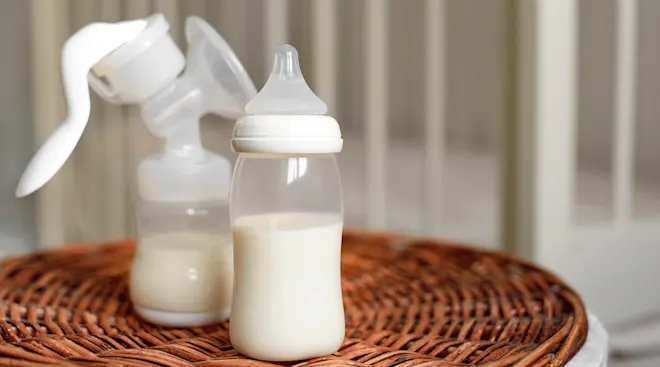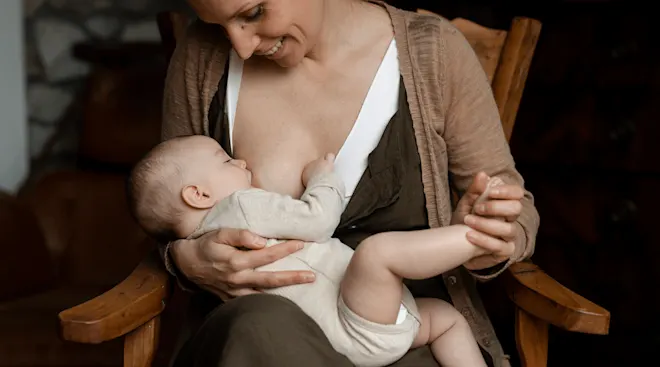7 Ways Your Breasts Change After Breastfeeding
Truth: Women’s bellies aren’t the only thing to inflate during pregnancy. Over the course of those 40 weeks, your breasts also swell to epic proportions—but that’s nothing compared to the voluptuous size and, dare we say, perkiness you’ll enjoy as a nursing mom once baby arrives. The question is, what will become of your breasts after breastfeeding? Of course, what breasts look like before and after breastfeeding depends on the person, since every woman’s body is different. Still, there are several changes likely in store for you. Wondering what they are? Read on.
Breasts, weather naturally big or small, will stretch and grow during pregnancy thanks to an influx of hormones and your newly activated milk ducts. It’s normal, it’s Mother Nature, and by golly, for a lot of us it’s fabulous. “Many women notice their breast cup size increase by several sizes during pregnancy. These changes become even more pronounced while breastfeeding because the breasts are actively producing milk,” says Heather Bartos, MD, an ob-gyn and board certified lactation consultant based in Cross Roads, Texas. The thing is, once the skin, tissues and tendons have shape-shifted to accommodate your milk-heavy breasts, they’ll maintain a slightly stretched shape, leading to a, um, relaxed look. Of course, having saggy breasts after breastfeeding isn’t entirely the fault of pregnancy or nursing. In fact, aging, a high BMI, your pre-preg bra size and a history of smoking all heavily influence one’s sag potential.
If you’re trying to figure out how to get your breasts back after breastfeeding, “exercises that strengthen the chest muscles can sometimes help the breasts look more lifted,” says Stephanie Nguyen, RN, a board certified lactation consultant and founder of Modern Milk, a breastfeeding clinic and prenatal-postnatal education center in Scottsdale, Arizona. Zero in on your pectoral muscles (around the breasts) or latissimus dorsi (the side muscles that cause bra overhang) to get the most bang for your boob, but don’t expect the size and shape of your boobs to drastically change.
Real talk: Breastfeeding boobies leak. They can leak when you hear a baby (any baby) cry. They can leak when you’re at capacity or when you’ve missed a feed—heck, they can even leak when you’re getting frisky. Think that’ll all be behind you once you stop breastfeeding? What you may not know is that it takes an average of 42 days for the breast duct tissue to shrink after you’ve weaned, Bartos says. That means a lot of women experience leaking and letdown sensations for a few weeks to a few months after they’ve stopped breastfeeding. To help put a stop to the leaks, Bartos recommends wearing a tighter fitting sports bra that offers absolutely no inadvertent nipple stimulation.
Breasts get bigger while you’re breastfeeding, but once you stop and your milk dries up, it’s only natural for them to deflate a bit. So does that mean you’re destined to have small breasts after breastfeeding? Not really, says Nguyen. (Relief!) Instead, they may simply appear smaller. “This is because the skin is a bit more stretched and the connective tissue and fatty tissue in the breasts can shift during pregnancy and breastfeeding,” she says. “But most women can expect that their breasts will return to a similar size that they were pre-pregnancy.”
Noticing tangles of new-to-you veins cupping your breast is often one of the very first signs of pregnancy. That’s because blood volume increases by up to 40 percent during pregnancy, making veins (especially the veins under your breasts’ thin skin) more visible. And a lot of that uptick in blood flow remains during breastfeeding. “The veiny appearance, however, will typically return to normal once you’ve weaned your baby,” Nguyen says. Another thing about your breasts after breastfeeding? Your nipples and areolas should also return to their pre-nursing state.
As your breasts grow during pregnancy and breastfeeding, the skin naturally expands, making them susceptible to stretch marks. In fact, one study in the Journal of American Academy of Dermatology found that 33 percent of women developed stretch marks on their breasts during pregnancy. But good news: While stretch marks usually start out as red or purple streaks, they often lighten within a year—which means they may not be so visible on your breasts after breastfeeding. As Nguyen says, “Many women find that stretch marks on their breasts are barely noticeable once they stop nursing.” There’s not a lot you can do to prevent stretch marks, but if you regularly massage your mama stripes with a good cream or oil, Nguyen says, “you can help alleviate some of the symptoms associated with stretch marks, like itching.”
News flash: Most women’s breasts are uneven—and that’s before pregnancy and breastfeeding, Bartos notes. (So are your eyes and ears. No big whoop.) The expansion your boobs undergo while breastfeeding, however, can magnify that natural lopsidedness. “Different breast sizes may also have differing number of milk ducts or production capabilities, so women may notice the asymmetry more while breastfeeding,” Bartos says. (Note that if your babe prefers to nurse on one side over the other, that’s actually not going to cause asymmetry.) So can you avoid getting tilted tities? Not so much. “Give it some time after you’ve weaned,” Bartos says. “Your breasts may simply be returning to ‘normal’ on different time frames.” Her advice? Wait about 12 weeks before even entertaining the thought that you’ve got a cosmetic concern in your bra. Unevenness] marked by several cup sizes, however, should be evaluated by your physician, Bartos says, to make sure there isn’t a mass or other issue, like an abscess or clogged milk duct, in your larger breast.
Don’t be too quick to judge your breasts after breastfeeding. According to Nguyen, it takes about three months after fully weaning for your breasts to settle into their new normal. Once the three months are up, hightail it to a good lingerie store, get a professional bra fitting and restock. “Some women want to save money and just put their old bras back on, but the truth is, the girls have changed,” Bartos says. They deserve a fresh start, and so do you. “Be proud of your breasts—they’ve nourished and given life to your precious little one!” Nguyen says. Your body is doing the best it can, just like you.
Published July 2019
Please note: The Bump and the materials and information it contains are not intended to, and do not constitute, medical or other health advice or diagnosis and should not be used as such. You should always consult with a qualified physician or health professional about your specific circumstances.
Plus, more from The Bump:
Navigate forward to interact with the calendar and select a date. Press the question mark key to get the keyboard shortcuts for changing dates.




















































